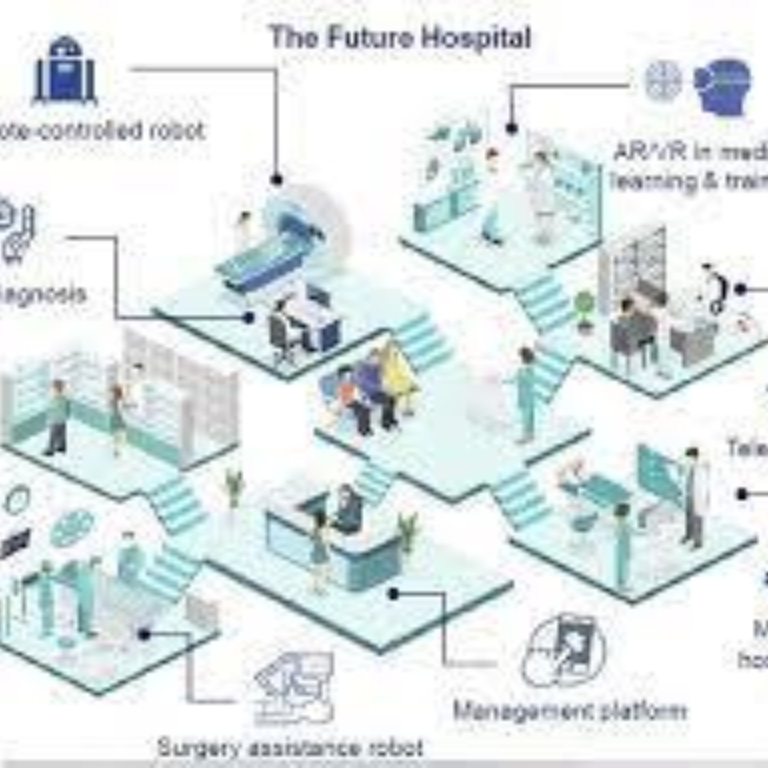5G Transformation Hub
How 5G is Transforming Healthcare
Thai mobile operator True and Huawei have deployed a standalone 5G network and mobile edge computing (MEC) to enable Siriraj Hospital in Bangkok to dramatically improve the efficiency and effectiveness of healthcare.
The 5G connectivity is being used in conjunction with artificial intelligence to accelerate a range of medical processes, including emergency interventions and pathological diagnosis.
Select a project
Contents
Challenge
In Thailand and many other countries, an aging population means healthcare systems are under strain. Moreover, medical resources are unevenly distributed – this is especially true in rural areas, where there are less than two doctors for every 10,000 people. In emergency situations, people need to be treated as fast as possible - one-third of critically ill patients die in an ambulance on the way to a hospital.
Solution
5G connectivity is being used to relay information about a patient travelling in an ambulance to medics in the hospital so they can prepare ahead of the patient’s arrival at the emergency room. It can also be used to enable remote consultations with experts to provide real-time and comprehensive first aid treatment. Further, 5G connectivity within the hospital is enabling the emergency department to closely monitor in-patients’ conditions and alert physicians, as necessary. The hospital is also employing 5G and artificial intelligence to improve pathological diagnosis systems.
Impact & Statistics
Since the 5G technology was put into use in late 2021, the survival rate of emergency patients has been greatly improved, according to Visit Vamvanij, Director of Siriraj Hospital, Thailand's largest public hospital. "Saving time means saving lives," he told the Xinhua news service in March 2022. "As soon as the patient arrives at the hospital, everybody knows what to do." Moreover, the introduction of AI has lowered the average time taken to obtain pathological diagnoses results from 15 minutes to 25 seconds per case.
Wider Implications
The Siriraj 5G Smart Hospital project could serve as a blueprint for more smart hospitals in Thailand and elsewhere. Over time, the 5G-enabled processes being implemented in Siriraj Hospital could be deployed more widely, helping to address the pain points in the Thai healthcare system. As well as reducing the number of deaths in ambulances, the solution could help healthcare providers serve many more people.
Stakeholders
True, Huawei, Siriraj Hospital in Bangkok
02
How 5G is Transforming Healthcare
The introduction of 5G has improved the survival rate of emergency patients
Thai mobile operator True and Huawei have deployed a standalone 5G network and edge computing to enable Siriraj Hospital in Bangkok to dramatically improve the efficiency and effectiveness of healthcare.
The 5G is being used to relay real-time information about a patient travelling in an ambulance to medics in the hospital so they can prepare ahead of the patient’s arrival at the emergency room. That information could include vital signs, video images and medical records.
Since the 5G technology was deployed in late 2021, the survival rate of emergency patients has been greatly improved, according to Visit Vamvanij, Director of Siriraj Hospital, Thailand's largest public hospital. "Saving time means saving lives," he told the Xinhua news service in March 2022. "As soon as the patient arrives at the hospital, everybody knows what to do."
The 5G connectivity on board the ambulance can also be used to enable remote consultations with experts to provide real-time and comprehensive first aid treatment. That’s very important because one-third of critically-ill patients die in an ambulance on the way to the hospital, according to Prof. Dr. Prasit Watanapa, Dean of the Faculty of Medicine for Siriraj Hospital at Mahidol University. “5G-connected ambulances provide timely emergency treatment based on 5G HD cameras and AR (augmented reality) glasses,” Dr. Watanapa told Huawei’s Lighting Up the Future summit at MWC 2022 in Barcelona in February 2022.
The 5G connectivity within the hospital also provides the emergency department with an advanced system to closely monitor in-patients’ conditions and alert physicians, as necessary. “In the hospital you have a smart ER (emergency room), with 5G mobile trolleys making mobile ward rounds, and conducting consultation and examination,” Dr. Watanapa told the summit.
Siriraj Hospital is also using 5G connectivity to help it harness artificial intelligence (AI) to achieve further improvements in patient outcomes. For example, the introduction of AI has seen the time take to deliver pathological diagnoses results fall from 15 minutes to 25 seconds per case, Dr. Watanapa told the Xinhua news service. The high-speed 5G connectivity can also be used to provide remote surgery instruction via real-time HD and AR displays, he explained at the summit. “And post-hospital, we have 5G-connected remote consultation, which can be done at home or in a local community hospital.”
Patients with chronic conditions, such as diabetes, could also benefit from the digitisation of healthcare. By drawing on the data collected by 5G-connected devices, AI could support the monitoring, assessment and notification for patients with non-communicable diseases. Dr. Watanapa notes that connected wearable devices, such as smart watches, can facilitate the collection of health data and healthcare analytics.
Integrated into a hybrid public-private 5G network, Siriraj Hospital’s new edge facility enables hospital staff to also use 5G to access the on-site data centre directly without exposing potentially sensitive data traffic to a public network. “Cloud computing makes information storage and sharing easier. Big data helps doctors and management make better decisions,” Dr. Watanapa told the Huawei Summit at MWC. “And AI improves the speed, efficiency and precision of medical imaging. So new ICT technologies are making healthcare more intelligent, convenient and efficient.”


Dr. Prasit Watanapa
Dean of the faculty of Medicine for Siriraj Hospital at Mahidol university
03
Exploring many more 5G applications
The Faculty of Medicine Siriraj Hospital, Mahidol University and Huawei have established a Joint Innovation Lab to incubate innovative 5G applications. It expects to research and develop 30 5G medical applications in 2022. These will include using a blockchain for electronic health records – a solution that is designed to enable high-speed access and entry of patients’ data – and a smart system to optimise pharmacy inventory and supply chain management.
Moreover, Siriraj Hospital is trialing the use of 5G to enable unmanned vehicles to support logistics. Equipped with 5G, a self-driving car can deliver medicines and medical equipment from the pharmaceutical department to other hospital buildings. True says the combination of 5G and edge compute enables the vehicles to operate automatically or be controlled and monitored via secure, low latency connectivity. Siriraj Hospital is also piloting 5G portable medical boxes, 5G medical carts and 5G smart hospital beds.
Crucially, 5G has the bandwidth and responsiveness to support audio-visual communications in 4K resolution, enabling clear medical and remote and online consultation. "5G made this a reality as it provides a high-speed network with low latency, which increases the overall efficiency of data transfers, patient monitoring, data collection and analytics, as well as remote medical care, " Dr. Watanapa told the Xinhua news service.
Huawei says that 5G technology will optimise healthcare experience for both providers and patients by an unprecedented level of connectivity, while boosting the precision and efficiency of medical treatment. Thailand claims to have the best 5G coverage of the 10 countries in ASEAN (the Association of Southeast Asian Nations).

04
Helping Thailand cope with rising healthcare costs
The Siriraj 5G Smart Hospital project, which has been in development since mid-2020, is backed by the National Broadcasting and Telecommunications Commission (NBTC) and the government’s Thailand 4.0 initiative to digitally transform the country, one objective of which is “high value healthcare”.
Since 2019, Thailand's healthcare costs have exceeded its per capita GDP growth, according to YCP Solidiance, an Asia-focused management consulting firm[1]. Total household healthcare expenditure had significantly grown from 359 billion baht in 2015 to 436 billion baht (US$11.9 billion) in 2019, as the prevalence and severity of chronic diseases is growing along with the elderly population. Thailand has insufficient hospitals to manage the health needs of the country’s population, according to YCP Solidiance, which says Thailand has 2.1 hospital beds per 1,000 people, compared with the global average of 2.7.
In his speech at the Summit at MWC, Dr. Watanapa described how the Covid-19 pandemic has sped up the digital transformation of healthcare, spurring greater adoption of wearables, audio visual communication, cloud computing, big data management and AI-assisted medical imaging. “We're going to provide new experiences, a new model, and new operations by using the new technologies, the 5G, the AI, the Internet of Things and also the edge clouds,” he said. “We put a lot of effort in doing research in order to improve the effectiveness and the efficiency of healthcare system in the country.”
The combination of multi-access edge computing and 5G private networks provides high security and a better network experience, Dr. Watanapa added, noting the potential to “connect virtually everyone and everything together including machine objects and devices, together with the use of cloud technology and artificial intelligence.”
Over time, the smart hospital solution being implemented in Siriraj Hospital could be deployed more widely, helping to address the pain points in the Thai healthcare system. “We want to make Siriraj 5G smart hospital a model for the healthcare sector, so as to drive the digital transformation of the entire health industry in Thailand, even in the ASEAN region," Abel Deng, CEO of Huawei Technologies (Thailand), told the Xinhua news service.
As well as reducing the number of deaths in ambulances, the solution is intended to enable healthcare providers to reach adn serve more people. Today, medical resources are unevenly distributed – this is especially true in rural areas, where there are less than two doctors for every 10,000 people.
“The 5G Siriraj Hospital vision is to improve social well being and enhance the productivity and efficiency in healthcare services,” Dr. Watanapa told the summit at MWC Barcelona. He expects the Siriraj 5G Smart Hospital project to “serve as a model for upgrading Thailand’s public health industry in the future.”
The government of Thailand intends to invest a substantial amount in IT, starting with 50 billion baht (US$1.4 billion) this year, the figure will go up to 1,000 billion baht within 10 years (US$27.4 billion), Dr. Watanapa added. He is looking forward to the “rising prosperity brought by connectivity and digital technologies in the future. Our collaboration between other faculty or medicinal hospital and Huawei will enhance and upgrade the services of the hospital. … we'll be able to expand to cover other ASEAN countries and ultimately to enhance the quality of healthcare system in this region of the world.”
[1] Source: https://ycpsolidiance.com/whit...

Sources
- 1. Source: https://ycpsolidiance.com/white-paper/the-future-of-smart-hospitals-in-thailand

Dr. Prasit Watanapa
Dean of the faculty of Medicine for Siriraj Hospital at Mahidol university
05
About
About the GSMA
The GSMA is a global organisation unifying the mobile ecosystem to discover, develop and deliver innovation foundational to positive business environments and societal change. Our vision is to unlock the full power of connectivity so that people,
industry, and society thrive. Representing mobile operators and organisations across the mobile ecosystem and adjacent industries, the GSMA delivers for its members across three broad pillars: Connectivity for Good, Industry Services and Solutions, and Outreach. This activity includes advancing policy, tackling today’s biggest societal challenges, underpinning the technology and interoperability that make mobile work, and providing the world’s largest platform to convene the mobile ecosystem at the MWC and M360 series of events.
For more information, please visit the GSMA corporate website at www.gsma.com.
Follow the GSMA on Twitter: @GSMA.
GSMA 5G Transformation Hub
The GSMA 5G Transformation Hub is a source of information on some of the most innovative 5G solutions in the world. This portal contains case studies detailing design, benefits, key players, measured value and the future impact of scaling up these 5G solutions worldwide. The 5G Era is now firmly established and this family of standardised GSM technologies, including mmWave, are being rolled out successfully across the globe. The GSMA 5G Transformation Hub, launched at MWC Barcelona in 2022, provides details of how 5G is best placed to deliver real value for a range of key sectors including manufacturing, energy, transportation, media and live entertainment, smart cities and construction.. Many more case studies will be added, in the coming months, covering even more industries and the GSMA is asking Members to nominate innovative 5G case studies to add to this global digital showcase. The 5G Transformation Hub and this particular Case Study are both sponsored by Qualcomm.
About this case study
This case study is for information only and is provided as is. The GSM Association makes no representations and gives no warranties or undertakings (express or implied) with respect to the study and does not accept any responsibility for , and hereby disclaims any liability for the accuracy or completeness or timeliness of the information contained in this document. Any use of the study is at the users own risk and the user assumes liability for any third party claims associated with such use.